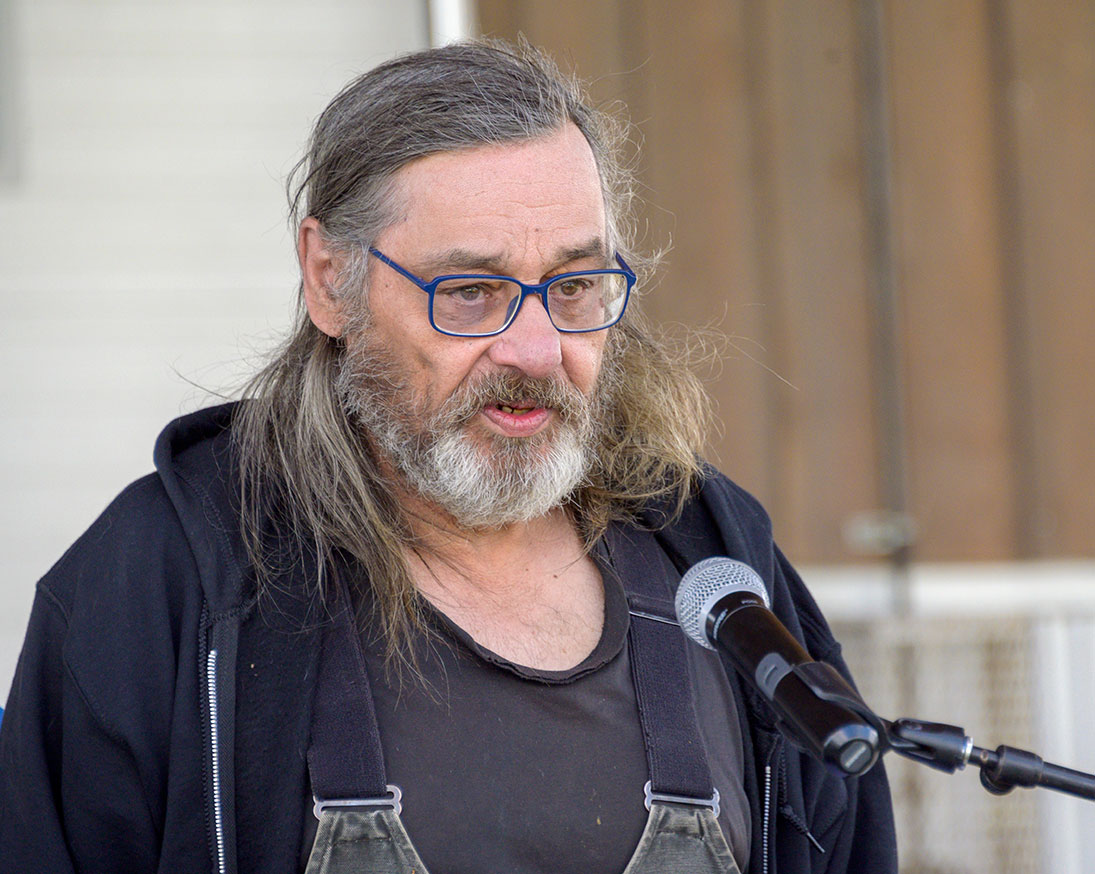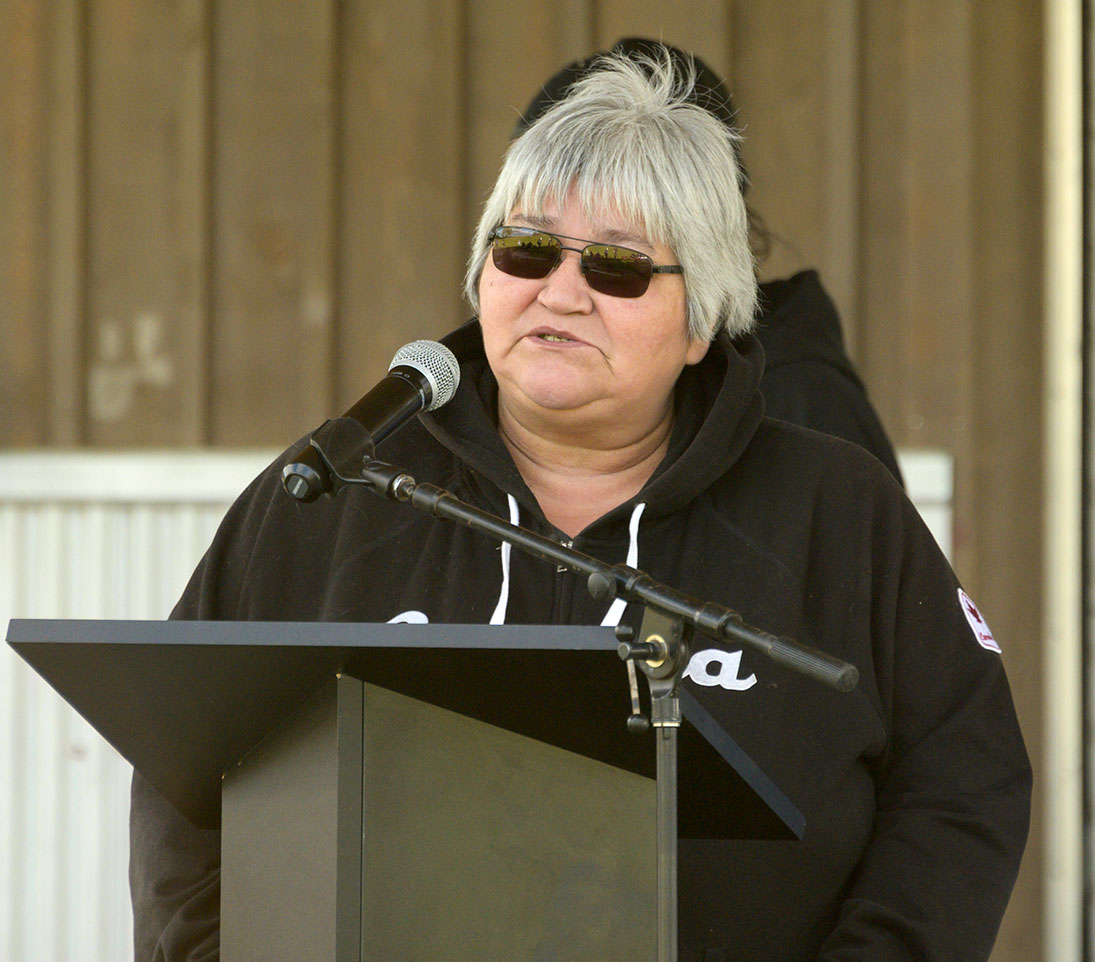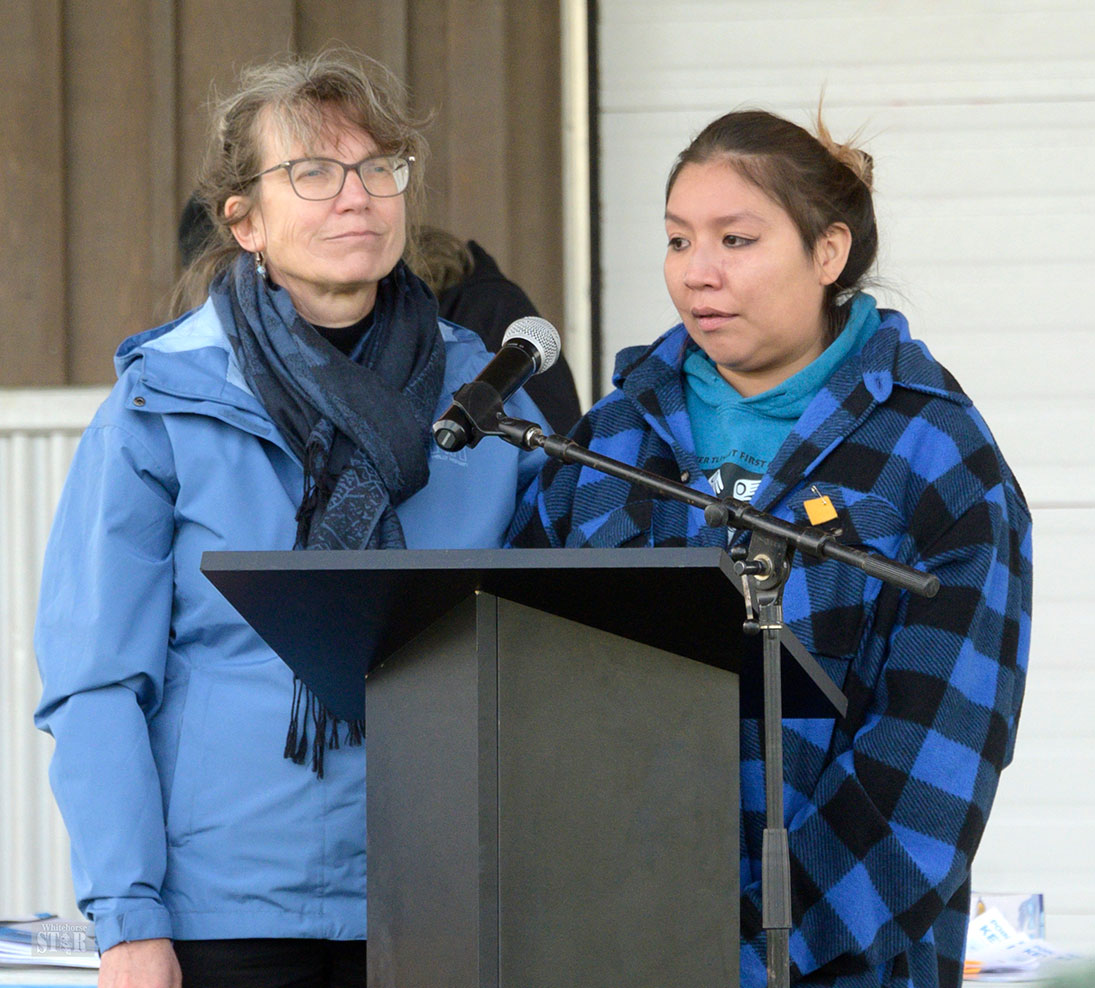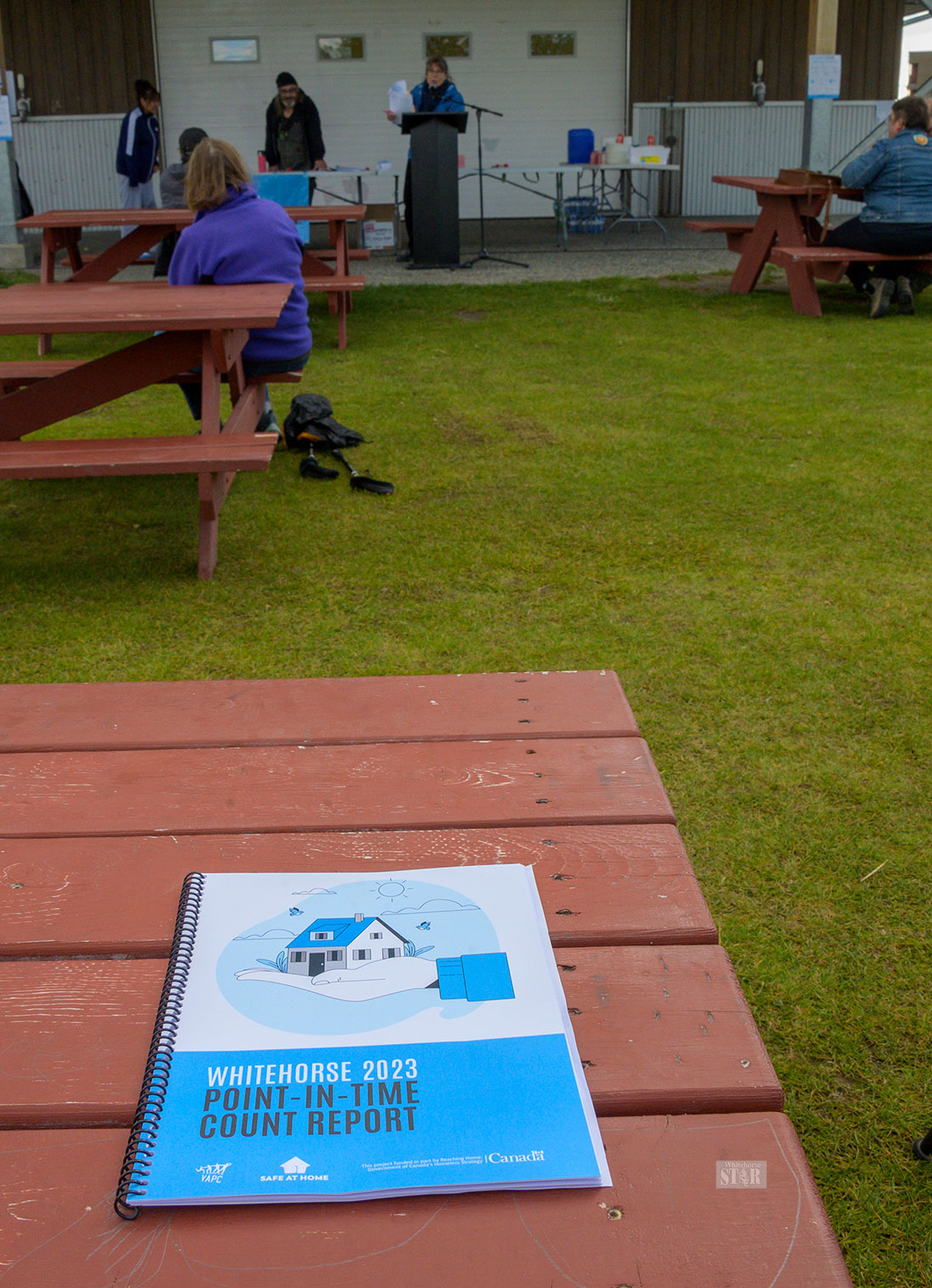
Photo by Vince Fedoroff
THE TOOLS ARE AT HAND – Bill Bruton says the key question is: ‘How badly do we want to end homelessness?’

Photo by Vince Fedoroff
THE TOOLS ARE AT HAND – Bill Bruton says the key question is: ‘How badly do we want to end homelessness?’

Photo by Vince Fedoroff
REFORMS NEEDED AT SHELTER – Karen Nicloux is calling for operational changes at the Whitehorse Emergency Shelter.

Photo by Vince Fedoroff
‘FEELING IGNORED’ – Autumn Carlick (right) speaks at Wednesday’s event. Looking on is Kristina Craig, the executive director of the Yukon Anti-Poverty Coalition.

Photo by Vince Fedoroff
DATA COMPILED – The Point-in-Time Count Report is seen at the site of Wednesday’s announcement.
That more and more people are struggling to find housing in Whitehorse is not a surprise.
That more and more people are struggling to find housing in Whitehorse is not a surprise.
A newly released count now confirms more people are also ending up experiencing homelessness, with a larger proportion of those people being left out on the street or in shelters.
The results from April’s point-in-time homelessness count in White-horse were released Wednesday.
The results show an increase of 30 per cent in homelessness since the last count in 2021, with 197 people reporting they were experiencing some form of homelessness.
“It’s alarming and it’s disheartening,” said Kristina Craig, the executive director of the Yukon Anti-Poverty Coalition.
This is the fourth such count in Whitehorse and the first since 2021.
It provides a snapshot of how many people were experiencing homelessness in a 24-hour period, and is part of a federal government program designed to collect comparable data in jurisdictions across Canada.
Numbers show increasing total homelessness in Whitehorse and an increase in the number of people experiencing “absolute homelessness” meaning they are sleeping out or are staying in an emergency shelter.
The results were made public in an announcement at Shipyards Park on a blustery afternoon.
Many attendees had lived the experience of homelessness.
One of those is Bill Bruton, who is now a co-chair of the advisory board responsible for overseeing the count, and who gave opening remarks.
“The question that needs asking is how badly do we want to end homelessness?” Bruton said. “We ask this question because we have all the tools at hand.”
Bruton was referring to the fact that they know the solution is affordable housing.
Craig expanded on this, saying it is “deeply affordable and stable housing” that people need to get out of a cycle of homelessness they are stuck in.
“We actually know what the solutions are to ending homelessness in the territory,” Craig said, adding that it is “systems that are failing, not people that are failing.”
The counting efforts revealed that 65 per cent of respondents had spent more than half of the past three years without housing.
She said there is no “silver bullet” to fix this, but it is obvious that part of the solution is building more housing.
Craig said it is essential that people support new housing development, considering the magnitude of the shortage.
“I am not 100-per-cent keen on that tree coming down, but we need more housing stock,” she said.
Craig also said it’s necessary to actually listen to those people who are experiencing homelessness to get an accurate idea of individual needs.
“The ones actually experiencing homelessness are the ones we should be listening to the loudest,” Craig said.
A few of those people got up to speak after Craig had finished her remarks.
Autumn Carlick told of her issues in the cycle of homelessness and her inability to get permanent and stable housing.
“I’ve been trying to get housing for quite a while right now,” she said. “I’m starting to feel ignored on the bottom of the list.”
Karen Nicloux then got up to speak to tell her experience in the system. Nicloux talked about her addiction issues and the need for a safe space to get through that struggle.
Her issues were such that she needed a quiet place where she could get rest and get better.
But this is not the situation faced by many people who are forced to use the Whitehorse Emergency Shelter while also trying to overcome addiction and deal with the sickness that comes with that.
“We need to make the shelter a safe and sober place where people can actually rest and get up when they want to and not be herded out like cattle,” Nicloux said.
She was referencing what she says are policies not allowing people to remain in bed if they need to, and the harm reduction approach taken in the shelter’s operation.
The shelter is low-barrier, meaning staff will not turn people away if they are under the influence of drugs or alcohol.
Results from the recent counting efforts don’t attempt to solve these issues, but rather give an idea of how many people are experiencing different kinds of homelessness and what the issues and barriers are those people are facing.
Counting took place over the night of April 18. Of the 197 counted, 75 were experiencing absolute homelessness.
Absolute homelessness has increased in each count since 2018, going from 34.2 per cent, to 35 per cent in 2021 and 46 per cent this year.
Survey results also break down the count by ethnicity, gender and things such as health and substance use issues.
About 70 per cent of respondents reported having substance use issues, while almost 40 per cent had an illness or medical problem.
Asked about ethnicity, 90 per cent of respondents identified as Indigenous.
Not very many were new to the Whitehorse area, with about 35 per cent saying they had been in the area for over 10 years and a little over 40 per cent saying they’d been in Whitehorse their whole lives.
Craig cautioned that these numbers don’t count every single person in town experiencing homelessness because people have to volunteer to participate. This means the numbers are actually higher.
She said there are usually about 30 per cent who don’t get counted, bringing the total estimate of people experiencing homelessness in Whitehorse to about 300.
Craig said the goal is to reduce the number of homeless people in Whitehorse by 50 per cent by 2030.
In a place like Whitehorse, with only 300 people experiencing homelessness, Craig says tackling the issue is actually achievable, unlike large cities where the numbers of homeless reach into the thousands.
But, so far, the numbers are still going in the wrong direction.
“Our numbers are up instead of down,” she said.
In order to encourage thoughtful and responsible discussion, website comments will not be visible until a moderator approves them. Please add comments judiciously and refrain from maligning any individual or institution. Read about our user comment and privacy policies.
Your name and email address are required before your comment is posted. Otherwise, your comment will not be posted.
Comments (3)
Up 15 Down 14
George on Sep 17, 2023 at 7:03 pm
And still
The chilkoot sits empty.
Up 47 Down 4
Max Mack on Sep 17, 2023 at 2:06 pm
Despite spending untold millions of dollars on sheltering the 'homeless', mental health 'solutions', and harm reduction strategies, the activists are saying the problem is getting worse.
Makes one wonder if these policies are making these issues worse.
Up 17 Down 3
David on Sep 17, 2023 at 7:13 am
"In a place like Whitehorse, with only 300 people experiencing homelessness, Craig says tackling the issue is actually achievable, unlike large cities where the numbers of homeless reach into the thousands."
Greater Vancouver had about ten times the number of homeless people as Whitehorse does, but it also has almost 100 times the population. It is achievable in large cities.